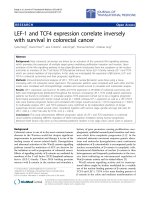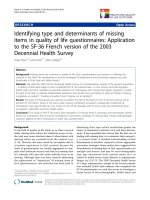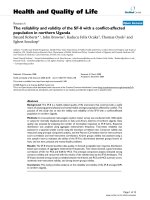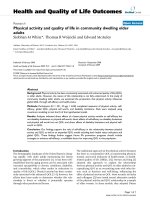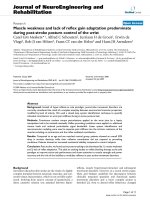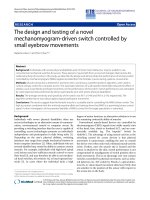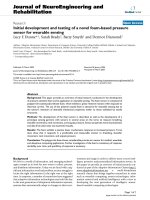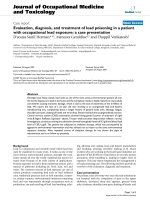báo cáo hóa học:" Efficacy, Safety and Pharmacokinetics of Once-Daily Saquinavir Soft-Gelatin Capsule/Ritonavir in Antiretroviral-Naive, HIV-Infected Patients" pot
Bạn đang xem bản rút gọn của tài liệu. Xem và tải ngay bản đầy đủ của tài liệu tại đây (356.92 KB, 12 trang )
BioMed Central
Page 1 of 12
(page number not for citation purposes)
Journal of the International AIDS
Society
Open Access
Research
Efficacy, Safety and Pharmacokinetics of Once-Daily Saquinavir
Soft-Gelatin Capsule/Ritonavir in Antiretroviral-Naive,
HIV-Infected Patients
Montaner SG Julio*
1
, Malte Schutz
2
, Robert Schwartz
3
,
Dushyantha T Jayaweera
4
, Alfred F Burnside
5
, Sharon Walmsley
6
and
Michael S Saag
7
Address:
1
St Paul's Hospital, University of British Columbia, Vancouver, BC, Canada,
2
Roche Laboratories, Inc, Nutley, New Jersey,
3
Associates in
Research, Fort Myers, Florida,
4
University of Miami School of Medicine, Miami, Florida,
5
Burnside Clinic, Columbia, South Carolina,
6
Toronto
Hospital, Toronto, Canada and
7
University of Alabama at Birmingham
Email: Montaner SG Julio* -
* Corresponding author
Abstract
Context: Once-daily HIV treatment regimens are being used in clinical practice with the objective
of improving patient acceptance and adherence.
Objective: To evaluate the efficacy and safety of saquinavir-soft-gelatin capsule (SGC)/ritonavir
combination (1600 mg/100 mg) vs efavirenz (600 mg) both once daily and combined with 2
nucleoside analogs twice daily.
Setting: Twenty-six centers in the United States, Canada, and Puerto Rico.
Patients: A total of 171 antiretroviral naive HIV-infected individuals were enrolled in a 48-week,
phase 3, open-label, randomized study.
Main Outcome Measure: Proportion of patients with HIV-RNA levels < 50 copies/mL. The
pharmacokinetic profile of saquinavir-SGC was analyzed in a subset of randomly selected patients.
Results: In the primary intent-to-treat population at week 48, 51% (38/75) and 71% (55/77) of
patients in the saquinavir-SGC/ritonavir and efavirenz groups, respectively, achieved HIV-RNA
suppression < 50 copies/mL (P = .5392, 95% 1-sided confidence interval [CI] = -33.5%). In the on-
treatment (OT) population, 73% (38/52) and 93% (54/58) of patients in the saquinavir-SGC/
ritonavir and efavirenz groups, respectively, had effective viral suppression < 50 copies/mL (P =
.5015, 95% 1-sided CI = -33.4%). Mean CD4+ cell counts increased by 239 and 204 cells/microliters
(mcL), in the saquinavir-SGC/ritonavir and efavirenz groups, respectively, in the OT analysis (P =
.058). Both regimens were reasonably well tolerated, although more gastrointestinal adverse
events were reported with saquinavir-SGC/ritonavir. Pharmacokinetic profiles in 6 patients
showed an observed median C
min
at 24 hours of 429 ng/mL (range, 681750 ng/mL).
Conclusion: Once-daily efavirenz was statistically superior to once-daily saquinavir-SGC/
ritonavir. Gastrointestinal adverse effects were commonly associated with treatment failure in the
saquinavir-SGC/ritonavir arm of the study.
Published: 10 May 2006
Journal of the International AIDS Society 2006, 8:36
This article is available from: />Journal of the International AIDS Society 2006, 8:36 />Page 2 of 12
(page number not for citation purposes)
Introduction
The introduction of highly active antiretroviral therapy
(HAART) has produced dramatic reductions in morbidity
and mortality rates associated with HIV-1 infection in the
United States.[1,2] In clinical trials, HAART has reduced
plasma HIV-1 RNA levels to less than 400 copies/mL in
60% to 90% of patients.[3] Strict adherence to HAART is
necessary to prevent viral replication and the emergence
of drug-resistant viruses, which can compromise the final
therapeutic benefit.[4,5] Treatment regimens with
improved dosing schedules, such as once-daily dosing, are
likely to improve patient acceptance and adherence.[6]
Furthermore, once-daily dosing of HAART may be partic-
ularly beneficial in the implementation of directly
observed therapy (DOT) in prisons, at needle-exchange
sites, and in drug rehabilitation programs.[4]
To date, 6 antiretroviral (ARV) agents, efavirenz, tenofo-
vir, didanosine, lamivudine, coformulated lamivudine/
abacavir, atazanavir and amprenavir boosted with ritona-
vir are approved for once-daily dosing by the US Food and
Drug Administration (FDA). However, in addition to
these drugs, there are several agents such as nevirapine
and other boosted protease inhibitors (PIs) that are being
used once daily in clinical practice based on their half
lives. The availability of a wide choice of once-daily treat-
ment regimens has made it easier for HIV-infected
patients to find an optimal therapy that suits their life-
style. While efavirenz appears to be an ideal once-daily
treatment option due to its potency and convenience with
a low pill burden,[7] adverse events, in particular relating
to the central nervous system, have been reported follow-
ing administration,[8] which may potentially limit its use
in some HIV-infected patients. Additionally, efavirenz
may not be appropriate in some settings because it may
have teratogenic effects.[8]
Ritonavir-boosted PI regimens are widely used in clinical
practice,[9,10] because several boosted PI combinations
have pharmacokinetic profiles that support once-daily
dosing.[11] These include saquinavir/ritonavir,[12]
amprenavir/ritonavir,[13] fosamprenavir/ritonavir,[14]
lopinavir/ritonavir [15] and atazanavir/ritonavir.[16] In
initial studies, positive pharmacokinetic and efficacy data
have been observed with the use of once-daily saquinavir/
ritonavir in PI-naive and experienced individuals.[12,17]
Therefore, to further investigate the saquinavir/ritonavir
boosted PI combination as a potential once-daily treat-
ment regimen, we evaluated the efficacy and safety of
saquinavir-soft-gelatin capsule (SGC)/ritonavir 1600 mg/
100 mg vs efavirenz 600 mg in a prospective, randomized,
multicenter clinical trial. Both treatment regimens were
administered once daily in addition to 2 nucleoside
reverse transcriptase inhibitors (NRTIs) (twice daily) as
part of combination HAART therapy regimens to ARV-
naive, HIV-infected individuals. As part of this clinical
study, the pharmacokinetic profile of saquinavir-SGC was
assessed in a subset of patients.
Materials and methods
Study Design
This was a phase 3, open-label, randomized, multicenter
study conducted at 26 centers in the United States, Can-
ada, and Puerto Rico. Antiretroviral-naive, HIV-infected
adults were randomized to receive either saquinavir-SGC/
ritonavir (1600 mg/100 mg, 9 pills) or efavirenz (600 mg,
3 pills) once daily, both in combination with 2 NRTIs
twice daily. An interim analysis was planned at week 24,
with a follow-up extension to week 48. Once patients
reached 48 weeks, they had the option of continuing in
the study until a common study closure (CSC) date or of
withdrawing at that time. The CSC date was the date on
which the last randomized patient reached 48 weeks of
treatment.
The NRTIs allowed in the study included the following
agents: zidovudine (AZT, Retrovir), lamivudine (3TC, Epi-
vir), 3TC/AZT (Combivir), stavudine (d4T, Zerit), or dida-
nosine (ddI, Videx). The NRTIs were selected by the
investigators following consultation with the study partic-
ipants, with the exception of didanosine, which was
dosed twice daily according to the FDA approval status at
the time this study was conducted. Patients were rand-
omized via stratification of the screening plasma HIV-
RNA value (500075,000 copies/mL vs > 75,000 copies/
mL). Saquinavir-SGC and ritonavir were to be taken at the
same time and with food. The study was designed and
monitored in accordance with Good Clinical Practices.
Prior approval was obtained from institutional review
boards/local ethics committees of the participating cent-
ers and written informed consent was obtained from all
study participants.
Patients
The defined study population consisted of male or female
(nonpregnant, nonnursing) adults (18 years or older),
with HIV-RNA values 5000 copies/mL and CD4+ cell
counts 75 cells/mcL. All patients were ARV-naive (no
more than 2 weeks of previous ARV therapy since HIV
diagnosis). Patients with significant laboratory abnormal-
ities, active hepatitis B or hepatitis C, severe hepatic
impairment, or malignancy requiring chemotherapy or
radiation therapy were excluded from the study.
Study Populations
All efficacy analyses were performed on the primary
intent-to-treat (ITT) and on-treatment (OT) populations.
The primary ITT population included all patients who
received at least 1 dose of study drug after randomization
and had at least 1 efficacy evaluation. The OT population
Journal of the International AIDS Society 2006, 8:36 />Page 3 of 12
(page number not for citation purposes)
included those patients in the study who had an observa-
tional value for all efficacy variables and laboratory meas-
urements, at that particular timepoint in the study. The
safety-evaluable population included all randomized
patients who received at least 1 dose of study medication
and had at least 1 postbaseline safety assessment.
Efficacy and Safety Measures
The primary efficacy variable was the proportion of
patients with plasma HIV-RNA values < 50 copies/mL
using the Ultra-Sensitive assay (Roche Diagnostics), at
weeks 24 and 48. Secondary efficacy analyses included the
change from baseline in CD4+ cell counts. Primary and
secondary variables were assessed at baseline (week 0),
every 4 weeks until week 24, and every 8 weeks until week
48, or at study discontinuation.
Adverse events were graded by intensity, and their rela-
tionship to the study medications was assessed. Fasting
lipid profile was also assessed. Laboratory abnormalities
were graded by severity. Marked laboratory shifts were
defined as a 3 grade shift from baseline (grade 03 or 4
and grade 14).
Pharmacokinetic Subanalysis
A subanalysis was performed to assess the pharmacoki-
netic profile of saquinavir-SGC in a subset of randomly
selected patients. Intensive pharmacokinetic assessments
were performed on patients from 2 preselected study cent-
ers after the completion of 4 weeks of therapy. Following
a standard breakfast, saquinavir-SGC/ritonavir 1600 mg/
100 mg was administered with 2 NRTIs. Samples for anal-
ysis of saquinavir-SGC (7 mL) were taken predosing (hour
0) and at 1, 2, 3, 4, 6, 8, 12, and 24 hours post-dose. At
week 4, single trough plasma concentrations of saquina-
vir-SGC were also determined in a larger group of
patients. For patients who took their dose in the morning,
single samples were taken before their next morning dose
(approximately 24 hours later) and for those who took
their dose in the evening, samples were taken at least 12
hours after the previous dose.
Pharmacokinetic Analysis
Saquinavir-SGC plasma concentration was assayed using
a validated SCIEX API liquid chromatography extraction
method with a mass spectrophotometric (LC-MS) detec-
tion system. The method was validated for a range of
53000 ng/mL. For patients who underwent intensive
pharmacokinetic evaluation, the variables assessed were
area under the curve over 24 hours (AUC
024 h
), maximum
plasma concentration (C
max
) and observed trough plasma
concentration (C
min
). C
max
and C
min
were read directly
from the observed data. The AUC data were obtained by
noncompartmental analysis.
In patients with a single trough plasma sample, C
min
at 24
hours (C
24 h
) was the pharmacokinetic variable of interest
and saquinavir-SGC C
24 h
was mathematically extrapo-
lated to reflect 24-hour levels, assuming an elimination
half-life of 56 hours.[18] The equation C
1
= C
0
e(-k
el
• t)
was used to calculate the saquinavir-SGC C
24 h
extrapo-
lated levels where: C
1
= concentration extrapolated at 24
hours; C
0
= observed concentration; k
el
= the elimination
rate constant for the drug (k
el
= 0.693/t 1/2); t = differ-
ence in time between C
1
and C
0
; and t 1/2 is defined as the
half-life of the drug.
Descriptive statistics for the pharmacokinetic parameters
of saquinavir-SGC were summarized to compare them
with historical values obtained with the licensed dose of
saquinavir-SGC (1200 mg 3 times daily [TID]).
Statistical Analyses
This study was designed to compare the efficacy of once-
daily dosing of saquinavir-SGC/ritonavir 1600 mg/100
mg vs efavirenz 600 mg at weeks 24 and 48, using the pro-
portion of patients with HIV-RNA values < 50 copies/mL
(response rate). Group differences in the proportion of
patients with HIV-RNA levels < 50 copies/mL were ana-
lyzed using a noninferiority test. The Farrington-Manning
method for testing noninferiority was used to derive P val-
ues and to construct 1-sided 95% confidence intervals
(CI) of the rate difference.[19] If the limit of the 95% 1-
sided CI of the difference rate was greater than -20%, then
noninferiority was concluded. Mean changes from base-
line in CD4+ cell counts were analyzed using an analysis
of variance (ANOVA) model. Safety variables were sum-
marized using descriptive statistics for the entire study
period up to the CSC date. Fisher's exact test was used to
statistically compare the incidence of adverse events in
both treatment groups.
Results
Patients and Study Course
From July 1999 to October 2001, 269 patients were
screened and 171 were randomized to treatment (Figure
1). Six patients withdrew from the primary ITT population
before receiving study medication, giving a total of 165
patients who received study drug. Of these, 13 patients
were excluded because no postrandomization on-drug
efficacy evaluation was available. The resulting primary
ITT population included 75 patients in the saquinavir-
SGC/ritonavir group and 77 patients in the efavirenz
group. Of the primary ITT population, 108 patients com-
pleted all 48 weeks of the study (51 in the saquinavir-
SGC/ritonavir group and 57 in the efavirenz group). At
week 48, the OT population consisted of 110 patients: 52
and 58 patients in the saquinavir-SGC/ritonavir and efa-
virenz arms, respectively. The safety population consisted
of 161 randomized patients: 81 and 80 patients in the
Journal of the International AIDS Society 2006, 8:36 />Page 4 of 12
(page number not for citation purposes)
saquinavir-SGC/ritonavir and efavirenz group, respec-
tively.
At the CSC date, 51/152 (34%) patients had withdrawn
from the primary ITT population: 28/75 (37%) patients
from the saquinavir-SGC/ritonavir group and 23/77
(30%) patients from the efavirenz group (Figure 1). Of
these, 18 patients withdrew due to failure to return for
reassessment (8 in the saquinavir-SGC/ritonavir arm and
10 in the efavirenz arm), 13 patients refused treatment/
withdrew consent (11 in the saquinavir-SGC/ritonavir
arm and 2 in the efavirenz arm), and 12 withdrew due to
adverse events (8 in the saquinavir-SGC/ritonavir arm and
4 in the efavirenz arm). The demographic and baseline
characteristics of the patients in the saquinavir-SGC/riton-
avir and efavirenz arms were similar, with respect to gen-
der, age, race, baseline HIV-RNA levels and CD4+ counts
(Table 1). The majority (73%) of patients in both arms
was male, 47% were black, and the age range was 1961
years (median, 36 years).
Efficacy
Plasma HIV RNA Response
As shown in Figure 2, in the primary ITT population at
week 24, 63% (47/75) and 83% (64/77) of patients in the
saquinavir-SGC/ritonavir and efavirenz groups, respec-
tively, had HIV-RNA values < 50 copies/mL (P = .5255,
95% 1-sided CI = -32.0%). At the 48-week time-point, the
respective values were 51% (38/75) and 71% (55/77) (P
= .5392, 95% 1-sided CI = -33.5%).
In the OT population, at week 24, 82% (46/56) and 90%
(61/68) of patients had HIV-RNA levels < 50 copies/mL in
the saquinavir-SGC/ritonavir and efavirenz groups,
respectively (P = .0374, 95% 1-sided CI = -19.05%). By
week 48, 73% (38/52) and 93% (54/58) of patients had
HIV-RNA levels < 50 copies/mL, respectively (P = .5015,
95% 1-sided CI = -33.3%).
Changes in CD4+ Cell Counts
At week 24, the mean increase in CD4+ cell counts was
170 cells/mcL in the saquinavir-SGC/ritonavir arm com-
pared with 143 cells/mcL in the efavirenz arm (P = .344;
OT population). At the 48-week study endpoint, this had
increased to 239 cells/mcL and 204 cells/mcL, in the
saquinavir-SGC/ritonavir and efavirenz groups, respec-
tively (P = .058; OT population).
Study design and completion statusFigure 1
Study design and completion status. ITT = intent to treat
Efavrienz arm, n = 85
Saquinavir soft gelatin capsule/ritonavir arm, n = 86
*Up to the common study closure date (October 02, 2001 ± 2 weeks).
Randomized
n = 171
Withdrew prior
to receiving study drug
n = 4
Withdrew prior to
received study drung
n = 2
Efficacy evaluation
not available
n = 6
Withdrew from study*
(n = 23)
Refused treatment n = 2
Failure to return n = 10
Adverse event n = 4
Laboratory toxicity n = 3
Insufficient therapeutic response n = 2
Other n = 2
Efficacy evaluation
not available
n = 7
Withdrew from study*
(n = 28)
Refused treatment n = 11
Failure to return n = 8
Adverse event n = 8
Laboratory toxicity n = 0
Insufficient therapeutic response n = 1
Other n = 0
Received treatment
as allocated
n = 82
Received treatment
as allocated
n = 83
Took medication and had
an efficacy evaluation
(Primary ITT population)
n = 75
Took medication and had
an efficacy evaluation
(Primary ITT population)
n = 77
Completed 48-week study
n = 51
Completed 48-week study
n = 57
Journal of the International AIDS Society 2006, 8:36 />Page 5 of 12
(page number not for citation purposes)
Safety
Overall, adverse events were reported by 98% and 94% of
patients in the saquinavir-SGC/ritonavir and efavirenz
groups, respectively. The majority of adverse events were
mild or moderate in intensity. During the entire study
period, 11% (18/161) of patients in the safety population
discontinued treatment due to adverse events. In the
saquinavir-SGC/ritonavir group 15% (12/81) of patients
experienced adverse events that led to withdrawal and 8%
(6/80) of patients withdrew from the efavirenz group due
to adverse events. The most commonly reported adverse
events leading to withdrawal in the saquinavir-SGC/riton-
avir group were gastrointestinal in nature, including nau-
sea and vomiting. In contrast, weight loss, peripheral
neuropathy and abnormal dreams were the reported
adverse events leading to withdrawal in the efavirenz
group.
Adverse events of moderate, severe or life-threatening
intensity that were considered possibly or probably
Table 1: Summary of Patient Characteristics at Baseline (Primary Intent-to-Treat Population)
Characteristic Saquinavir-SGC 1600 mg + ritonavir 100
mg, Once Daily (n = 75)
Efavirenz 600 mg Once Daily (n = 77)
Male n (%) 53 (71) 58 (75)
Female n (%) 22 (29) 19 (25)
Race n (%)
White 28 (37) 29 (38)
Black 34 (45) 38 (49)
Hispanic 6 (8) 8 (10)
Other 7 (9) 2 (3)
Age (y); mean ± SD(range) 37.2 ± 9.7 (2061) 37.2 ± 9.9 (1961)
Weight (kg); mean ± SD (range) 78.0 ± 16.5 (52126) 75.4 ± 15.0 (44136)
Plasma HIV RNA (log
10
copies/mL); mean ± SD
(range)
4.8 ± 0.6 (3.346.49) 4.7 ± 0.5 (3.515.66)
CD4+ cell count (cells/mcL); mean ± SD (range) 372 ± 190 (751025) 343 ± 180 (80900)
Nucleoside reverse transcriptase inhibitor
combination therapy; n (%)
3TC-AZT 47 (63) 52 (68)
3TC-d4T 27 (36) 22 (29)
3TC-ddI 0 2 (3)
AZT-ddI 1 (1) 0
d4T-ddI 0 1 (1)
Stratification (HIV RNA); n (%) copies/mL
500075,000 39 (52) 43 (56)
> 75,000 copies/mL 36 (48) 34 (44)
SGC = soft gelatin capsule; SD = standard deviation; 3TC = lamivudine; AZT = zidovudine; d4T = stavudine; ddI = didanosine.
Journal of the International AIDS Society 2006, 8:36 />Page 6 of 12
(page number not for citation purposes)
related to study medication occurring in 2% or more of
patients are shown in Table 2 . Overall, 42% (34/81) and
29% (23/80) of patients in the saquinavir-SGC/ritonavir
and efavirenz groups, respectively, reported at least 1
adverse event of moderate, severe, or life-threatening
intensity considered possibly or probably related to study
medication. Among adverse events, the rates of nausea
differed significantly among treatment groups (Table 2).
In total, 15 patients (7 [8.6%] and 8 [10.0%] patients in
the saquinavir-SGC/ritonavir and efavirenz groups,
respectively) reported at least 1 serious adverse event,
none of which were considered to be related to study
medication. One patient in the saquinavir-SGC/ritonavir
group died due to myocardial infarction, which again was
not considered to be related to study medication.
Laboratory Variables
Overall, laboratory grade shifts in hematology and chem-
istry values were similar in both treatment groups. Grade
3/4 total cholesterol laboratory shifts were reported in 3
patients in the saquinavir-SGC/ritonavir group compared
with 7 patients in the efavirenz group. Mean triglyceride
and total cholesterol levels assessed throughout the 48-
week study period are presented in Figure 3. At weeks 24
and 48, mean changes in triglyceride values from baseline
were 29.4 mg/dL and 51.2 mg/dL, respectively, in the
saquinavir-SGC/ritonavir group, compared with 27.0 mg/
dL and 71.4 mg/dL, respectively, in the efavirenz group.
The differences between groups were not statistically sig-
nificant at weeks 24 and 48. Mean changes in total choles-
terol levels were comparable between the 2 treatment
arms throughout the 48-week study period. Mean changes
in high-density lipoprotein cholesterol at weeks 24 and 48
were 7.9 mg/dL and 8.7 mg/dL, respectively, in the
saquinavir-SGC/ritonavir group compared with 9.3 mg/
dL and 12.1 mg/dL, respectively, in the efavirenz group.
Pharmacokinetics
Of 72 patients who were enrolled in the pharmacokinetic
sub-analysis, 6 underwent intensive pharmacokinetic
evaluation. Sixty-five patients had single plasma samples
taken at week 4 and data from 44 patients were suitable
for evaluation of trough concentrations (data from the
remaining 21 could not be extrapolated because the sam-
ples from 11 patients were taken less than 12 hours after
the previous dose and the remaining 10 patients were
noncompliant). Furthermore, of the 6 patients included
in the intensive pharmacokinetic analysis, 1 patient was
noncompliant and, therefore, not included in the single-
trough evaluable cohort of patients. The single-trough
evaluable cohort, therefore, consisted of 49 patients (5
patients with intensive pharmacokinetics and 44 with sin-
gle pharmacokinetic evaluations).
Percentage of patients treated with either saquinavir-soft gelatin capsule/ritonavir or efavirenz both once-daily in combination with 2 nucleoside reverse transcriptase inhibitors, with undetectable HIV-RNA levels (< 50 copies/mL), as detected by the Ultra-Sensitive assayFigure 2
Percentage of patients treated with either saquinavir-soft gelatin capsule/ritonavir or efavirenz both once-
daily in combination with 2 nucleoside reverse transcriptase inhibitors, with undetectable HIV-RNA levels (<
50 copies/mL), as detected by the Ultra-Sensitive assay. ITT = intent to treat; OT = on treatment
100
80
60
40
20
0
04812162024 32
Time (Weeks)
40 48
HIV RNA , 50 Copies/mL
(% Patients)
Saquinavir soft gelatin
capsule/ritonavir (ITT)
Saquinavir soft gelatin
capsule/ritonavir (OT)
Efavirenz (ITT)
Efavirenz (OT)
Journal of the International AIDS Society 2006, 8:36 />Page 7 of 12
(page number not for citation purposes)
Table 2: Clinical Adverse Events Considered to Be at Least Possibly or Probably Related to Treatment, at Least of Moderate, Severe
or Life-Threatening Intensity, and Occurring in 2% of Patients in the Safety Population
Adverse Event (ordered by body system) Saquinavir-SGC 1600 mg + ritonavir 100 mg,
Once Daily (n = 81)
Efavirenz 600 mg Once Daily (n = 80)
n (%) n (%)
Gastrointestinal disorders
Nausea* 18 (22.2) 3 (3.8)
Vomiting NOS 5 (6.2) 0
Diarrhea NOS 4 (4.9) 4 (5.0)
Abdominal pain NOS 2 (2.5) 0
Diarrhea aggravated 2 (2.5) 0
Esophageal reflux 2 (2.5) 0
General disorders
Fatigue 2 (2.5) 4 (5.0)
Dizziness (excluding vertigo) 1 (1.2) 4 (5.0)
Skin and subcutaneous tissue disorders
Dermatitis NOS 1 (1.2) 5 (6.3)
Metabolic and nutritional disorders
Appetite decreased 3 (3.7) 1 (1.3)
Neurologic disorders
Headache NOS 2 (2.5) 2 (2.5)
Insomnia 1 (1.2) 2 (2.5)
Weakness 2 (2.5) 0
Psychiatric disorders
Depression NOS 2 (2.5) 1 (1.3)
Anxiety 1 (1.2) 2 (2.5)
Abnormal dreams 0 2 (2.5)
Vascular disorders
Hypertension NOS 0 2 (2.5)
SGC = soft gelatin capsule; NOS = not otherwise specified.
*P = .0004; Fisher's exact test.
Journal of the International AIDS Society 2006, 8:36 />Page 8 of 12
(page number not for citation purposes)
Intensive Pharmacokinetic Analysis at 4 Weeks
The intensive pharmacokinetic profile of the 6 unselected
patients evaluated at 9 time points over 24 hours is shown
in Figure 4. The median observed C
min
at 24 hours, C
max
and AUC
024
for these 6 patients were 429 ng/mL (range,
681750 ng/mL), 6435 ng/mL (range, 172013,400 ng/
Mean levels of triglycerides and total cholesterol in the safety population of patients treated with either saquinavir-soft gelatin capsule/ritonavir or efavirenz both once daily in combination with 2 nucleoside reverse transcriptase inhibitorsFigure 3
Mean levels of triglycerides and total cholesterol in the safety population of patients treated with either
saquinavir-soft gelatin capsule/ritonavir or efavirenz both once daily in combination with 2 nucleoside reverse
transcriptase inhibitors.
250
200
150
100
50
0
04812162024
Time (Weeks)
mg/dL
32 40 48
Triglycerides
Saquinavir soft gelatin
capsule/ritonavir
Total cholesterol
Saquinavir soft gelatin
capsule/ritonavir
Triglycerides
Efavirenz
Total cholesterol
Efavirenz
Intensive pharmacokinetic profile of 6 patients at week 4Figure 4
Intensive pharmacokinetic profile of 6 patients at week 4. EC50 = concentration for 50% maximal effect.
100000
10000
1000
100
10
0
04812
EC
50
for Saquinavir
Time (Hours)
Saquinavir Soft Gelatin Capsule
Concentration (ng/mL)
16 20 24
Journal of the International AIDS Society 2006, 8:36 />Page 9 of 12
(page number not for citation purposes)
mL), and 66,920 ng.h/mL (range, 10,542137,563 ng.h/
mL), respectively.
Saquinavir-SGC Trough Levels at Week 4
The median saquinavir-SGC C
24 h
extrapolated level at
week 4 for all evaluable patients (n = 49) was 376 ng/mL
(range, 2.55709 ng/mL). Eight patients had saquinavir-
SGC C
24 h
extrapolated levels under the in vivo concentra-
tion for half-maximal effect (EC
50
) value of 50 ng/mL
(range, 2.545.2 ng/mL).[20] Despite this, these patients
had sustained HIV viral load suppression up to week 24.
There was no significant correlation between saquinavir-
SGC C
min
values and the reduction in plasma HIV RNA
values from baseline to week 48.
Discussion
This 48-week study compared the efficacy and safety of
the once-daily HIV treatment regimens, including
saquinavir-SGC/ritonavir 1600 mg/100 mg, to that of efa-
virenz 600 mg. The primary ITT analysis showed that a
higher proportion of patients in the efavirenz-treated
group achieved HIV-RNA levels < 50 copies/mL compared
with the saquinavir-SGC/ritonavir-treated group. More
patients withdrew from randomized treatment due to gas-
trointestinal disorders in the saquinavir-SGC/ritonavir
arm. The lower virologic response rate observed in the
saquinavir-SGC/ritonavir arm in the ITT population was
predominately due to the high rate of discontinuations,
with 37% of patients withdrawing from the saquinavir/
ritonavir arm, compared with 30% from the efavirenz
arm. These withdrawals were related to gastrointestinal
side effects, and possibly higher pill counts (patients tak-
ing saquinavir-SGC/ritonavir had to take 9 capsules at 1
time compared with 3 efavirenz capsules, together with
the background NRTIs). This study included a high per-
centage of African-American patients and no specific
adherence intervention was provided to overcome the dif-
ference in pill burden in the 2 treatment arms.
A previous comparative randomized trial of the boosted
PI saquinavir-SGC/ritonavir has also shown lower viro-
logic response rates, which have been attributed to differ-
ences in study withdrawal rates as a result of
gastrointestinal toxicities in the saquinavir-SGC study
arms.[21] In the MaxCmin 2 study, which compared
twice-daily saquinavir-SGC/ritonavir with lopinavir/
ritonavir, comparable viral suppression was demonstrated
in the OT analyses; however, the difference in study with-
drawal rates due to gastrointestinal toxicity in the saquina-
vir-SGC/ritonavir arm led to a lower overall response in
the ITT analyses.[21] The gastrointestinal toxicities
encountered in the saquinavir-SGC study arm of MaxC-
min 2 were attributed to the glyceride capmul component
of the SGC formulation of saquinavir.
Saquinavir is available in 2 formulations: the SGC formu-
lation, Fortovase, and the original hard capsule (HC)
saquinavir mesylate formulation, Invirase. In the present
study, the SGC formulation of saquinavir was used. As a
sole PI (unboosted), the oral bioavailability and effective-
ness of saquinavir with the SGC formulation is higher
than that of the HC formulation. This difference is due to
the glyceride excipient component of the SGC formula-
tion, capmul, which allows saquinavir to dissolve and dis-
perse rapidly upon administration. However, the SGC
formulation is associated with more gastrointestinal
adverse events.[22,23] In a recent study of the saquinavir/
ritonavir boosted regimen, the HC formulation of
saquinavir mesylate demonstrated similar exposure to the
SGC formulation but was better tolerated.[22,24] Conse-
quently, it might be expected that the tolerability issues
encountered in this study could be ameliorated if the HC
saquinavir mesylate formulation of saquinavir was used.
Interestingly, in a further study the boosted saquinavir-
HC/ritonavir 1600 mg/100 mg regimen demonstrated
potent viral suppression (89% of patients had HIV RNA
values < 50 copies/mL) with no patients withdrawing
from the study due to adverse events.[25] Of note, the
saquinavir mesylate is now available as a 500-mg film-
coated tablet, which is similar in size to the saquinavir
mesylate 200 mg HC.
Changes in lipid levels have been associated with the use
of NRTIs and PIs and, consequently, the impact on lipid
levels should be an important consideration when choos-
ing a treatment regimen.[26] With PIs, this risk has been
shown to be greatest with ritonavir, intermediate with
amprenavir and nelfinavir, and lowest with indinavir and
saquinavir.[27,28] The recently approved PI, atazanavir
appears to have little effect on lipid concentra-
tions.[16,27] The lower doses of ritonavir (100200 mg)
that are suitable for boosted saquinavir/ritonavir regi-
mens may result in some increases of fasting triglyceride
and cholesterol levels.[29] The data from this study con-
firm a low lipid profile risk associated with a once-daily
saquinavir-SGC/ritonavir dose of 1600 mg/100 mg. Dur-
ing this study, data evolved regarding the contribution of
NRTIs to hyperlipidemia and a post-hoc analysis was con-
ducted that demonstrated that the predicting factor for
hyperlipidemia in this study appeared to be the use of sta-
vudine as the background NRTI.[30]
Efavirenz once daily is a highly effective and commonly
prescribed part of ARV therapy; however, it may not be
suitable for all patients. Patients taking efavirenz may
experience central nervous system adverse events such as
dizziness, insomnia, poor concentration, and vivid
dreams.[8] With the recent classification of efavirenz as
pregnancy category D caution, it is advised in the treat-
ment of women of child-bearing potential. Also, efavirenz
Journal of the International AIDS Society 2006, 8:36 />Page 10 of 12
(page number not for citation purposes)
use may be a cause for concern in drug users currently tak-
ing methadone because efavirenz-mediated reduction of
methadone blood concentrations has also been
reported.[31,32] No methadone dose adjustments have
been found to be required in patients receiving once-daily
saquinavir/ritonavir 1600 mg/100 mg therapy.[33]
The results of the pharmacokinetic sub-analysis illustrated
that a once-daily regimen including saquinavir-SGC/
ritonavir 1600 mg/100 mg provides a median AUC
024 h
of
66,920 ng.h/mL. This is significantly higher than might be
anticipated following the unboosted saquinavir SGC regi-
men of 1200 mg 3 times daily, where the AUC
08 h
is 7249
ng.h/mL.[34] In addition, the median observed C
min
at 24
hours for saquinavir-SGC of 429 ng/mL was substantially
higher than the EC
50
value of 50 ng/mL.[20] There is some
evidence that failure on PI therapy can be linked to low
plasma concentrations,[35] but in this study no relation-
ship was found between HIV RNA concentrations and
saquinavir C
min
values.[36] Currently, with antiretroviral
therapy, it is unknown which pharmacokinetic parameter
correlates best with efficacy.[37] While there is some evi-
dence that failure on PI therapy can be linked to low C
min
plasma concentrations,[20] in this study no relationship
was found between HIV RNA concentrations and saquina-
vir C
min
values.
In conclusion, once-daily efavirenz was statistically supe-
rior to the saquinavir-SGC/ritonavir (1600 mg/100 mg)
once-daily regimen, as part of combination ARV therapy.
Gastrointestinal adverse effects were commonly associ-
ated with (ITT) treatment failure in the saquinavir-SGC/
ritonavir arm of the study, which may be attributed to the
SGC formulation used in this study. Future studies should
evaluate the use of the saquinavir mesylate formulation,
which has demonstrated similar exposure to the ritonavir-
boosted SGC formulation with a better tolerability profile
and by virtue of the 500-mg tablet also provides a lower
pill burden.
Authors and Disclosures
Julio S.G. Montaner, MD, has disclosed that he has
received grant support from Abbott Laboratories,
Agouron (a Pfizer company), Avexa Ltd, Boehringer Ingel-
heim Pharmaceuticals, Bristol-Myers Squibb, Gilead Sci-
ences, GlaxoSmithKline, Hoffman-La Roche, Incyte,
Merck Frosst Laboratories, Pfizer Canada, Tibotec Phar-
maceuticals, and Trimeris.
Malte Schutz, MD, has disclosed that he is an employee of
Roche Laboratories.
Robert Schwartz, MD, has disclosed that he has served on
the Advisory Board for Roche and GlaxoSmithKline.
Dushyantha T. Jayaweera, MD, has disclosed that he has
served on the speaker's bureau and/or received grant sup-
port from Hoffman-La Roche, Bristol-Myers Squibb, Glax-
oSmithKline, Boehringer Ingelheim Pharmaceuticals, and
Tibotec Pharmaceuticals.
Alfred F. Burnside, MD, has disclosed no relevant finan-
cial relationships.
Sharon Walmsley, MD, has disclosed that she has served
on the speaker's bureau and advisory boards for Hoffman-
La Roche, Bristol-Myers Squibb, GlaxoSmithKline, Abbott
Laboratories, Merck, Gilead Sciences and Pfizer.
Michael S. Saag, MD, has disclosed that he has served as a
consultant to and been a member of the speaker's bureau
of Achillion Pharmaceutical, Boehringer Ingelheim, Bris-
tol-Myers Squibb, Gilead Sciences, GlaxoSmithKline, Pan-
acos, Agouron (a Pfizer company), Progenics, Roche
Laboratories, Tanox, Tibotec-Virco, Trimeris, Vertex, and
ViroLogic. He has also disclosed that he has received
grant/research support from Gilead Sciences, GlaxoSmith-
Kline, Panacos, Agouron (a Pfizer company), Roche Lab-
oratories, Serono, and Tibotec, Inc.
FOCUS Study Team
Nicholaos Bellos, MD, Southwest Infectious Disease Asso-
ciates, Dallas, Texas; Alfred F. Burnside Jr, MD, Burnside
Clinic, Columbia, South Carolina; Joseph Cervia, MD,
Comprehensive HIV Center, New Hyde Park, New York;
Ann C. Collier, MD, University of Washington School of
Medicine, Seattle, Washington; Paul Cook, MD, ECU
School of Medicine, Greenville, North Carolina; Stephen
Follansbee, MD, HIV Clinical Trials Unit, San Francisco,
California; Joseph C. Gathe Jr, MD, Houston, Texas; Bruce
Hathaway, MD, ECU School of Medicine, Greenville,
North Carolina; Margaret Hoffman-Terry, MD, Lehigh
Valley Hospital AAO, Allentown, Pennsylvania; Dushyan-
tha T. Jayaweera, MD, University of Miami School of Med-
icine, Miami, Florida; Jazila Alattar Mantis, MD, Queens
Hospital Center, Jamaica, New York; Joseph Masci, MD,
Elmhurst Medical Center, Elmhurst, New York; Julio S.G.
Montaner, MD, St Paul's Hospital, Vancouver, British
Columbia, Canada; Mahmoud Mustafa, MD, Physicians'
Home Service PC, Washington, DC; Kristin Ries, MD,
University of Utah, Salt Lake City, Utah; Robert J. Roland,
DO, Infectious Disease Specialists, Union, New Jersey;
Danielle Rouleau, MD, CHUM, Montreal, Quebec;
Michael S. Saag, MD, AIDS Outpatient Clinic, Birming-
ham, Alabama; Stefan Schneider, MD, Living Hope Clini-
cal Trials, Long Beach, California; John Schrank, MD, ID
Care Center, Greenville, South Carolina; Malte Schutz,
MD, Illinois Masonic Medical Center, Chicago, Illinois;
Robert Schwartz, MD, Associates in Research, Fort Myers,
Florida; Gladys Sepulveda, MD, Anexo Hospital Oncolog-
Journal of the International AIDS Society 2006, 8:36 />Page 11 of 12
(page number not for citation purposes)
ica, Ponce, Puerto Rico; Leon Smith, MD, St Michael's
Medical Center, Newark, New Jersey; Joseph Timpone,
MD, Georgetown University Hospital, Washington, DC;
Paul Volberding, MD, UCSF AIDS Program, San Fran-
cisco, California; Sharon Walmsley, MD, The Toronto
Hospital, Toronto, Ontario.
Funding Information
This study was supported by a research grant from Roche
Pharmaceuticals.
Acknowledgements
We thank Pascal J. de Caprariis, MD, and Huilin Hu for assistance with the
trial. We also would like to express our thanks to the study coordinators
from all investigational sites.
References
1. Palella FJ, Delaney KM, Moorman AC, et al.: Declining morbidity
and mortality among patients with advanced human immu-
nodeficiency virus infection. HIV Outpatient Study Investiga-
tors. N Engl J Med 1998, 338:853-860. Abstract
2. Detels R, Munoz A, McFarlane G, et al.: Effectiveness of potent
antiretroviral therapy on time to AIDS and death in men
with known HIV infection duration. AIDS Cohort Study
Investigators. JAMA 1998, 280:1497-503. Abstract
3. Bartlett JA, DeMasi R, Quinn J, et al.: Overview of the effective-
ness of triple combination therapy in antiretroviral-naive
HIV-1 infected adults. AIDS 2001, 15:1369-1377. Abstract
4. Altice FL, Friedland GH: The era of adherence to HIV therapy.
Ann Intern Med 1998, 129:503-505.
5. Monforte d'Arminio A, Lepri AC, Rezza G, et al.: Insights into the
reasons for discontinuation of the first highly active antiret-
roviral therapy (HAART) regimen in a cohort of antiretrovi-
ral naive patients. I.CO.N.A. Study Group. Italian Cohort of
Antiretroviral-Naive Patients. AIDS 2000, 14:499-507. Abstract
6. Cohen CJ, Hellinger J, Norris D: Evaluation of simplified pro-
tease inhibitor dosing regimens for the treatment of HIV
infection. AIDS Read 2000, 10:296-299. 304307, 311313
7. Staszewski S, Morales-Ramirez J, Tashima KT, et al.: Efavirenz plus
zidovudine and lamivudine, efavirenz plus indinavir, and indi-
navir plus zidovudine and lamivudine in the treatment of
HIV-1 infection in adults. N Engl J Med 1999, 341:1865-1873.
Abstract
8. Sustiva (efavirenz capsules and tablets). In US Prescribing Infor-
mation New Jersey: Bristol-Myers Squibb; 2002.
9. DHHS Guidelines: Guidelines for the use of antiretroviral
agents in HIV-infected adults and adolescents. US Dept
Health and Human Services Panel on Clinical Practices for
Treatment of HIV Infection. Guidelines for the Use of Antiretroviral
Agents in HIV-1-Infected Adults and Adolescents
2005 [http://aid
sinfo.nih.gov/ContentFiles/AdultandAdolescentGL.pdf].
10. BHIVA Writing Committee: British HIV association (BHIVA)
guidelines for the treatment of HIV-infected adults with
antiretroviral therapy. HIV Med 2001, 2:276-313. Abstract
11. Kilby JM, Hill A, Buss N: The effect of ritonavir on saquinavir
plasma concentration is independent of ritonavir dosage:
combined analysis of pharmacokinetic data from 97 subjects.
HIV Med 2002, 3:97-104. Abstract
12. Cardiello PG, Van Heeswijk RP, Hassink EA, et al.: Simplifying pro-
tease inhibitor therapy with once-daily dosing of saquinavir
soft-gelatin capsules/ritonavir (1600 mg/100 mg): HIVNAT
001.3 study. J Acquir Immune Defic Syndr 2002, 29:464-470. Abstract
13. Arasteh K, Wood R, Teofilo E, et al.: Amprenavir (APV) 600 mg/
ritonavir (RTV) 100 mg BID or APV 1200 mg/RTV 200 mg
QD given in combination with abacavir (ABC) and lamivu-
dine (3TC) maintains efficacy in ART naive HIV-1 infected
adults over 24 weeks (APV20001). Eighth European Conference on
Clinical Aspects and Treatment of HIV Infection, Athens, Greece, October
2831, 2001 . Abstract 218
14. Gathe JC Jr, Ive P, Wood R, et al.: SOLO: 48-week efficacy and
safety comparison of once-daily fosamprenavir/ritonavir ver-
sus twice-daily nelfinavir in naive HIV-1-infected patients.
AIDS 2004, 8:1529-1537.
15. Eron J, Bernstein B, King M, et al.: Once-daily versus twice daily
Kaletra (lopinavir/ritonavir) in antiretroviral-naive HIV+
patients: 48 week follow-up. Ninth Conference on Retroviruses and
Opportunistic Infections, Seattle, Washington, February 2428, 2002 .
Abstract 409
16. Piliero PJ: Atazanavir: A novel once-daily protease inhibitor.
Drugs Today (Barc) 2004, 40(11):901-912.
17. Peytavin G, Landman R, Lamotte C, et al.: Saquinavir (SQV)
plasma and intracellular concentrations in a once daily dos-
ing combination Fortovase[R] (SQV-SGC)-low dose ritona-
vir (RTV) in a prospective study (IMEA 015) in HIV-infected
patients. Second International Workshop on Clinical Pharmacology of
HIV Therapy, Noordwijk, The Netherlands 2001. Abstract 3.16
18. Buss N, Snell P, Bock J, et al.: Saquinavir and ritonavir pharma-
cokinetics following combined ritonavir and saquinavir (soft
gelatin capsules) administration. J Clin Pharmacol 2001,
52:255-264.
19. Farrington CP, Manning G: Test statistics and sample size for-
mulae for comparative binomial trials with null hypothesis of
non-zero risk difference or non-unity relative risk. Stat Med
1990, 9:1447-1454. Abstract
20. Gieschke R, Fotteler B, Buss N, et al.: Relationships between
exposure to saquinavir monotherapy and antiviral response
in HIV-positive patients. Clin Pharmacokinet 1999, 37:75-86.
Abstract
21. Youle M, Gerstoft J, Fox Z, et al.: The final 48 week analysis of a
phase IV, randomized, open-label, multicentre trial to eval-
uate safety and efficacy of lopinavir/ritonavir (400/100 mg
BID) versus saquinavir/ritonavir (1000/100 mg BID): the
MaxCmin 2 trial. Program and abstracts of the 9th European AIDS
Conference (EACS), Warsaw 2003. Abstract F11/3
22. Kurowski M, Sternfeld T, Sawyer A, et al.: Pharmacokinetic and
tolerability profile of twice-daily saquinavir hard gelatin cap-
sules and saquinavir soft gelatin capsules boosted with riton-
avir in healthy volunteers. HIV Med 2003, 4:94-100. Abstract
23. Mitsuyasu RT, Skolnik PR, Cohen SR, et al.: Activity of the soft gel-
atin formulation of saquinavir in combination therapy in
antiretroviral-naive patients. AIDS 1998, 12:F103-109. Abstract
24. Cardiello P, Monhaphol T, Mahanontharit A, et al.: Pharmacokinet-
ics (PK) of once daily saquinavir-hard gels caps (SQV-HGC)
and saquinavir-soft gel caps (SQV-SGC) boosted with riton-
avir (RTV) in HIV-1+ Thai patients: HIV NAT001.4 substudy.
Program and abstracts of the 3rd International Workshop on Clinical Phar-
macology of HIV Therapy, Washington DC 2002. Abstract 1.2
25. Ananworanich J, Hill A, Siangphoe U, Ruxrungtham K, et al.: Staccato
Study Group. A prospective study of efficacy and safety of
once-daily saquinavir/ritonavir plus two nucleoside reverse
transcriptase inhibitors in treatment-naive Thai patients.
Antivir Ther 2005, 10:761-767. Abstract
26. Dale E, Manuney J, Uffelman K, et al.: Incidence of lipodystrophy
in START (Selection of Thymidine Analog Regimen Ther-
apy) Studies. Program and abstracts of the 1st International Workshop
on Adverse Drug Reactions and Lipodystrophy in HIV; June 2628, San
Diego, California 1999. Abstract 30
27. Dube MP, Stein JH, Aberg JA, et al.: Adult AIDS Clinical Trials
Group Cardiovascular Subcommittee; HIV Medical Associa-
tion of the Infectious Disease Society of America. Guidelines
for the evaluation and management of dyslipidemia in
human immunodeficiency virus (HIV)-infected adults receiv-
ing antiretroviral therapy: recommendations of the HIV
Medical Association of the Infectious Disease Society of
America and the Adult AIDS Clinical Trials Group. Clin Infect
Dis 2003, 37:613-627. Abstract
28. Moyle GJ, Baldwin C: Lipid abnormalities during saquinavir soft
gel-based highly active antiretroviral therapy. Program and
abstracts of the 39th Interscience Conference on Antimicrobial Agents and
Chemotherapy; September 2629, 1999; San Francisco, California .
Abstract 1292
29. O'Brien WA, Rojo D, Acosta E, et al.: Switch of Saquinavir 400
mg/ritonavir 400 mg to saquinavir 1000 mg/ritonavir 100 mg
during BID four drug antiretroviral therapy in patients with
viral load less than 200 copies/mL. Program and abstracts of the
3rd International Workshop on Clinical Pharmacology of HIV Therapy; April
1113, 2002; Washington, DC . Abstract 2.1
Publish with BioMed Central and every
scientist can read your work free of charge
"BioMed Central will be the most significant development for
disseminating the results of biomedical research in our lifetime."
Sir Paul Nurse, Cancer Research UK
Your research papers will be:
available free of charge to the entire biomedical community
peer reviewed and published immediately upon acceptance
cited in PubMed and archived on PubMed Central
yours — you keep the copyright
Submit your manuscript here:
/>BioMedcentral
Journal of the International AIDS Society 2006, 8:36 />Page 12 of 12
(page number not for citation purposes)
30. Walmsley S, Montaner J, Hill A, et al.: Nucleoside reverse tran-
scriptase inhibitor treatment as a risk factor for hyperlipi-
demia: results from the FOCUS trial. Antiviral Ther 2002, 7:L35.
31. Marzolini C, Troillet N, Telenti A, et al.: Efavirenz decreases
methadone blood concentrations. AIDS 2000, 14:1291-1292.
Abstract
32. Clarke SM, Mulcahy FM, Tija J, et al.: The pharmacokinetics of
methadone in HIV-positive patients receiving the non-nucle-
oside reverse transcriptase inhibitor efavirenz. Br J Clin Phar-
macol 2001, 51:213-217. Abstract
33. Munsiff AV, Einstein Coll A, Patel J: Regimens with once daily
ritonavir + Fortovase are highly effective in PI-experienced
HIV-HCV co-infected patients on Methadone. Program and
abstracts of the 39th Annual Meeting of the Infectious Diseases Society of
America (IDSA); October 2528, 2001; San Francisco, California . Abstract
684
34. Fortovase: EU Summary of Product Characteristics. 2006
[ />PI-en.pdf]. Accessed April 21
35. Durant J, Clevenbergh P, Garraffo R, et al.: Importance of protease
inhibitor plasma levels in HIV-infected patients treated with
genotypic-guided therapy: pharmacological data from the
Viradapt study. AIDS 2000, 14:1333-1339. Abstract
36. Schutz M, Goodly J, Chen K, et al.: Lack of correlation between
saquinavir trough levels and adverse events or clinical out-
comes in saquinavir cohort of focus study. Program and abstracts
of the 41st Annual Meeting of the Infectious Diseases Society of America
(IDSA); October 912, 2003; San Diego . Poster 1059
37. Back DJ, Khoo SH, Gibbons SE, et al.: The role of therapeutic drug
monitoring in treatment of HIV infection. Br J Clin Pharmacol
2001, 51:301-308. Abstract


